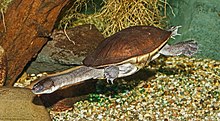Roti Island snake-necked turtle
This article needs additional citations for verification. (November 2023) |
| Roti Island snake-necked turtle | |
|---|---|

| |
| Roti Island snake-necked turtle | |
| Scientific classification | |
| Domain: | Eukaryota |
| Kingdom: | Animalia |
| Phylum: | Chordata |
| Class: | Reptilia |
| Order: | Testudines |
| Suborder: | Pleurodira |
| Family: | Chelidae |
| Genus: | Chelodina |
| Subgenus: | Chelodina |
| Species: | C. mccordi
|
| Binomial name | |
| Chelodina mccordi | |
| Synonyms[4][5] | |
| |
The Roti Island snake-necked turtle (Chelodina mccordi), also commonly known as McCord's snakeneck turtle,[6] is a critically endangered turtle species. It is named after Rote Island in Indonesia where it was first discovered. Some individuals were later discovered in East Timor, and are considered a distinct subspecies.
Taxonomy
Chelodina mccordi belongs to the genus Chelodina (Australian snake-necked turtles) within the family Chelidae (Austro-South American side-necked turtles).
Chelodina mccordi was originally described from Rote Island but was later split into three subspecies. Chelodina mccordi rotensis[7][8] from eastern Rote and Chelodina mccordi timorensis[9] from Timor. In a recent paper the eastern Rote form was found to be identical to the western form and they were synonymised.[10] This leaves the species with two subspecies one on Rote Island and one on Timor.
History
The Roti Island snake-necked turtle was split from the New Guinea snake-necked turtle and regarded as distinct species in 1994 after Dr. Anders Rhodin, director of the Chelonian Research Foundation Archived 2018-05-27 at the Wayback Machine in Lunenburg (Massachusetts), found differences between the two species. The first snake-necked turtles on Rote Island had been discovered in 1891 by George Albert Boulenger.
Etymology
Both the
Description
The
Habitat
The natural habitat of Chelodina mccordi includes swamps, rice terraces, and small lakes.
Reproduction
Adults of C. mccordi may have up to three breeding periods in a year. A typical clutch consists of eight to fourteen eggs. The size of an egg is 30 mm × 20 mm (1.18 in × 0.79 in) and may weigh 8–10 grams (0.28–0.35 oz). The first hatchlings emerge after incubating for three months, and the last hatchlings leave after four months. Upon emerging, a hatchling's shell is about 28 mm × 20 mm (1.10 in × 0.79 in) and has yellow spots on the plastron, which become darker in a few weeks until the entire plastron becomes almost black. As the juveniles grow, their coloration progressively becomes paler until they finally achieve the color of the adults.
Threats
The Roti Island snake-necked turtle is one of the most desired turtles in the international pet trade. Even before it was scientifically described it was so over-collected that the legal trade was prohibited in 2001 due to its rarity. The two or three remaining populations live in an area of only 70 km2 (27 square miles) in the central highlands of Rote Island. It is still illegally captured and it is often offered on markets under the label of the New Guinea snake-necked turtle which is also legally protected. In 2004 it was listed in Appendix II of CITES.
Outside of capture by humans there are few natural threats to this species. There are some reports of predation by feral pigs (
References
- . Retrieved 18 November 2021.
- ^ "Appendices | CITES". cites.org. Retrieved 2022-01-14.
- S2CID 59271531.
- ISBN 978-1-5323-5026-9.
- .
- ^ ISBN 978-1-4214-0135-5.
- S2CID 59580591.
- ^ McCord, W. P.; Joseph-Ouni, M. & Hagen, C. (2007). "A New Subspecies of Chelodina mccordi (Testudines: Chelidae) from Eastern Rote Island, Indonesia" (PDF). Reptilia. 52: 58–61.
- ^ McCord, W. P.; Joseph-Ouni, M. & Hagen, C. (2007). "A New Species of Chelodina (Testudines: Chelidae) from Eastern Timor Island (East Timor)" (PDF). Reptilia. 52: 53–57.
- S2CID 104293380.
- ^ Shepherd, Chris R.; Ibarrobdo, Bonggi (2005). The Trade of the Roti Island Snake-necked Turtle Chelodina mccordi (PDF) (Report). TRAFFIC Southeast Asia.
External links
- Asian Turtle Trade Working Group (2000). Chelodina mccordi. In: IUCN 2006. 2006 IUCN Red List of Threatened Species. <www.iucnredlist.org>. Downloaded on 27 July 2006. Database entry includes justification for why this species is critically endangered
- "Chelodina mccordi". Archived from the original on 2008-10-06.
- Inclusion of Roti Snake-necked Turtle Chelodina mccordi in Appendix II. Proponents: Indonesia and United States of America (PDF) (Report). Archived from the original (PDF) on 2007-12-14.
- TRAFFIC – Roti Island Snake-necked Turtles become all but extinct

